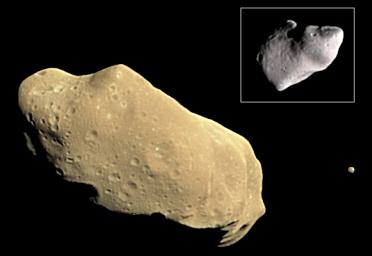- Original Caption Released with Image:
-
During its examination of the asteroid Ida, the Galileo spacecraft returned images of a second object, Dactyl--the first confirmed satellite or moon of an asteroid; the much smaller moon is visible to the right of Ida. Asteroids are small interplanetary bodies of rock or metal that mostly orbit the Sun in a belt between Mars and Jupiter, but others are known elsewhere in the solar system. The Galileo spacecraft surveyed Ida in 1993 on its way to explore the Jupiter system in 1995-97. This color picture was made from images taken by the imaging system on the Galileo spacecraft about 14 minutes before its closest approach to asteroid 243 Ida on August 28, 1993. The range from the spacecraft was about 10,500 kilometers (6,500 miles). The images used are from the sequence in which Ida's moon 1993 (2433)1 Dactyl was discovered. This picture contains images through the 4100-angstrom (violet), 7560 A (infrared) and 9680 A (infrared) filters. The color is "enhanced" in the sense that the CCD camera is sensitive to near infrared wavelengths of light beyond human vision; a "natural" color picture of this asteroid would appear mostly gray. Shadings in the image indicate changes in illumination angle on the many steep slopes of this irregular body as well as subtle color variations due to differences in the physical state and composition of the soil (regolith). There are brighter areas, appearing bluish in the picture, around craters on the upper left end of Ida, around the small bright crater near the center of the asteroid, and near the upper right-hand edge (the limb). This combination of more reflected blue light and greater absorption of near infrared light, suggest a difference in the abundance or composition of iron-bearing minerals in these areas. Ida's moon also has a deeper near-infrared absorption and a different color in the violet than any area on this side of Ida. The moon is not identical in spectral properties to any area of Ida in view here, though its overall similarity in reflectance and general spectral type suggests that it is made of the same basic rock types. Resolved images of Ida over a full rotation period (4.633 h) allowed detailed shape models to be developed, yielding volumes of 16,000+ -1,900 km cubed for Ida (mean radius, 15.7 km) and 1.4 km cubed for Dactyl (mean radius, 0.7 km; Belton et al., 1995, Nature, v. 374, p. 785- 788). These images and other data collected by the Galileo spacecraft may allow scientists to determine whether these asteroids are pieces of bigger ones that at one time partly melted and differentiated (forming a dense metallic core and rocky crust) or whether these are pieces of material unaltered since their formation during the birth of the Solar System.
- Image Credit:
-
NASA/JPL/USGS
Image Addition Date: -
1998-11-03
|

 Planetary Data System
Planetary Data System












